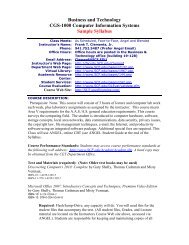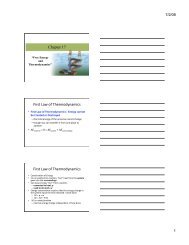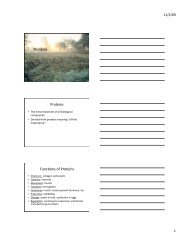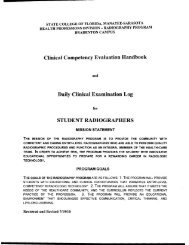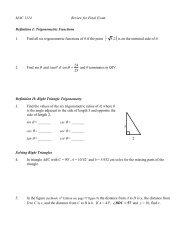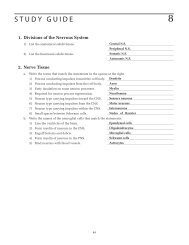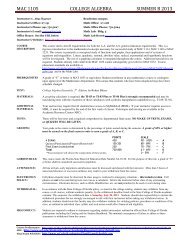Life and Nature - Scf - State College of Florida
Life and Nature - Scf - State College of Florida
Life and Nature - Scf - State College of Florida
Create successful ePaper yourself
Turn your PDF publications into a flip-book with our unique Google optimized e-Paper software.
<strong>Life</strong> <strong>and</strong> <strong>Nature</strong><br />
Am<strong>and</strong>a Orcutt<br />
ENC 1102<br />
7 December, 2011
Table <strong>of</strong> Contents<br />
• Introduction --- Page 3<br />
• Transcendentalism --- Page 5<br />
• Robert Frost --- Page 7<br />
• “After Apple Picking” --- Page 10<br />
• Modernism --- Page 12<br />
• W.B. Yeats --- Page 14<br />
• “The Lake Isle <strong>of</strong> Innisfree” --- Page 16<br />
• Romanticism --- Page 18<br />
• Robert W. Service --- Page 20<br />
• “My Cancer Cure” --- Page 22<br />
• Works Cited --- Page 25<br />
• Images Cited --- Page 28
Introduction<br />
“Your deepest roots are in nature. No matter who you are, where you live, or what kind <strong>of</strong><br />
life you lead, you remain irrevocably linked with the rest <strong>of</strong> creation.”<br />
--- Charles Cook, Awakening to <strong>Nature</strong>, 2001<br />
<strong>Life</strong> <strong>and</strong> <strong>Nature</strong> exist simultaneously, no matter what the medium is or location.<br />
<strong>Life</strong> is what makes <strong>Nature</strong> grow, but <strong>Nature</strong> is what gives us <strong>Life</strong>. One completes the<br />
other, no matter who the person is, or where the <strong>Nature</strong> grows. The three poets <strong>and</strong><br />
poems selected for this anthology reflect on what <strong>Nature</strong> means to them, as well as their<br />
interpretations on <strong>Life</strong>‟s relationship to <strong>Nature</strong>. Natural poetry does not always have<br />
to be about how beautiful a flower is or the sound <strong>of</strong> birds. It is more than that. It<br />
embraces everything all at once; the wind whistling through the trees, the sun rising <strong>and</strong><br />
setting over the l<strong>and</strong> exposing the farmer‟s harvest, the sensation you get when the<br />
person <strong>of</strong> subject interacts with the nature as if they are one person. Poems are not<br />
about what is on the surface; they are about what lies beneath the words <strong>and</strong> its hidden<br />
meaning. Poems that include these side-by-side themes are filled with interpretations,<br />
metaphors, personification, symbolism, <strong>and</strong> so on, <strong>and</strong> that is what makes them so<br />
powerful <strong>and</strong> meaningful.<br />
Interpretations <strong>and</strong> hidden meanings were not the main point for early nature<br />
poetry. The use <strong>of</strong> Natural poetry back in the 3 rd Century started when “the Greek<br />
poet Theocritus began writing idylls…to glorify <strong>and</strong> honor the simplicity <strong>of</strong> rural life”<br />
(“<strong>Nature</strong> Poems”). Some modern poets, like W.B. Yeats, are able to incorporate hints<br />
<strong>of</strong> this glorified rural life with symbolism <strong>and</strong> human life into their poems.
Introduction<br />
As the years move on, more poets, such as Dante <strong>and</strong> Petrarch, begin using<br />
another form <strong>of</strong> natural poetry called eclogue, which was created by Virgil in 37<br />
B.C.E. This poetry incorporates peace <strong>and</strong> serenity into rural places where<br />
shepherds can converse. This poetry “become something <strong>of</strong> a requirement for young<br />
poets [because it was a] form they had to master before embarking upon great original<br />
work” (“<strong>Nature</strong> Poetry”). Traditional nature poetry took a different turn <strong>and</strong> had the<br />
strongest influence on transcendentalists like Thoreau <strong>and</strong> Frost when William<br />
Wordsworth proposed that poetry “takes its origin from emotion recollected in<br />
tranquility (qtd. in “<strong>Nature</strong> Poems). The best way to find this tranquility is by going<br />
“into nature [to] observe the world… <strong>and</strong> translate…emotions <strong>and</strong> observations into<br />
verse,” which is exactly what Frost did (“<strong>Nature</strong> Poems”).<br />
Romantics are also keen in the wonderfulness <strong>of</strong> nature <strong>and</strong> its effect on life.<br />
From a Romantic‟s point <strong>of</strong> view, nature is a source <strong>of</strong> healthy feelings. “It is therapy<br />
for a diseased, overcivilized heart” (“Underst<strong>and</strong>ing <strong>of</strong> <strong>Nature</strong>”). <strong>Nature</strong> helps humans<br />
to find their emotional health, which can lead them to clarity, whether it is moral or<br />
spiritual. Self-identification is also a part <strong>of</strong> it. “Romantic „nature‟ is a vehicle for selfconsciousness”<br />
that either drives or carries a person to discover one‟s identity<br />
(“Underst<strong>and</strong>ing <strong>of</strong> <strong>Nature</strong>”). Robert W. Service is a poet that focuses on this in<br />
some <strong>of</strong> his poems, “My Cancer Cure” in particular. <strong>Nature</strong> can be a person‟s<br />
pathway to recovery <strong>and</strong> living a potential life, <strong>and</strong> Romantics are the ones that know it<br />
the best.
Transcendentalism<br />
American Transcendentalism is a movement rooted from Immanuel Kant, a<br />
German philosopher, <strong>and</strong> began to branch out <strong>and</strong> impact religion, literature,<br />
society, <strong>and</strong> philosophers in New Engl<strong>and</strong> from 1836-1860. This movement<br />
started with a reform approach in the Unitarian church, developed from the views<br />
<strong>of</strong> William Ellery Channing, <strong>and</strong> protested against the culture <strong>and</strong> society.<br />
Other than believing in the goodness <strong>of</strong> human <strong>and</strong> nature, transcendentalists<br />
believed that materialism, organized religion, <strong>and</strong> politics tainted individuals. “For<br />
the transcendentalists, the soul <strong>of</strong> each individual is identical with the soul <strong>of</strong> the<br />
world <strong>and</strong> contains what the world contains” (“American Transcendentalism”).<br />
“Unlike the Unitarians: they wanted to rejuvenate the mystical aspects <strong>of</strong> New<br />
Engl<strong>and</strong> Calvinism…<strong>and</strong> to go back to Jonathan Edwards' "divine <strong>and</strong><br />
supernatural light," imparted immediately to the soul by the spirit <strong>of</strong> God”<br />
(“American Transcendentalism”). One famous literary work <strong>of</strong> this time that<br />
sums up transcendentalism is <strong>Nature</strong> (1836) by Ralph Waldo Emerson. This<br />
essay demonstrates Emerson‟s appreciation towards all forms <strong>of</strong> nature,<br />
whether it is human nature or the natural world around him. Transcendentalists<br />
took everything out <strong>of</strong> society that corrupted individuals, <strong>and</strong> left what was<br />
beautiful <strong>and</strong> divine, that being nature.
Transcendentalism<br />
Robert Frost‟s work is the ideal work <strong>of</strong> a transcendentalist. His work helps<br />
to find refuge in a greedy world, as well <strong>and</strong> heal <strong>and</strong> find a common relationship<br />
with man <strong>and</strong> nature by using metaphors for one or the other. Even though he<br />
has poems that do not necessarily involve nature, his works ranging from “Out,<br />
Out” to “Mending Wall” to “After Apple Picking” all depict the philosophies <strong>of</strong><br />
life lessons from finding common ground <strong>and</strong> experiencing something greater than<br />
themselves. According to Nan Sisemore at Southeast High School, Frost<br />
takes common people in common places <strong>and</strong> puts them into his poems filled with<br />
nature <strong>and</strong> metaphors about the human condition <strong>and</strong> restores their “spirit<br />
through vigorous activities <strong>and</strong> communion with nature” (“Frost Lecture”). Frost<br />
filled his poems with New Engl<strong>and</strong> nature <strong>and</strong> settings typically in the winter, fall,<br />
or at night, because it causes his subjects to create “their own resources for<br />
survival” when isolated instead <strong>of</strong> reaching towards a materialistic society that<br />
would not underst<strong>and</strong> them or what it means to work towards something (“Frost<br />
Lecture”). Frost, though he did not live during a transcendentalist time, was<br />
unquestionably a transcendentalist poet that found a unique writing style to<br />
accompany what he stood for, believed in, <strong>and</strong> thought was pure form <strong>of</strong> reality in<br />
a tarnished society.
Robert Frost<br />
Robert Frost was born in San Francisco, surprisingly, on March 26, 1874. The<br />
famous New Engl<strong>and</strong> writer did not move to Massachusetts until after his father died<br />
when he was 11. Frost reminisced that his train ride to the other side <strong>of</strong> the country was<br />
“the longest, loneliest train ride” ever (qtd. in Ho “Robert Frost”). This displayed “the<br />
impact <strong>of</strong> the loss <strong>of</strong> a vital figure in Frost‟s childhood” (“Robert Frost”). As a child in<br />
school, his mother would read him works by many famous authors, one being Emerson,<br />
who became his favorite author, <strong>and</strong> possibly sparking his attraction to nature. The<br />
person who inspired him to start writing poetry was a high<br />
school friend, Carl Burell, who was “interested in botany [<strong>and</strong>]<br />
also an aspiring writer” (“Robert Frost”). Both Burell <strong>and</strong><br />
Frost wrote for the High School Bulletin <strong>and</strong> contributed<br />
verses <strong>and</strong> prose, one <strong>of</strong> which was a poem by Frost entitled,<br />
“La Noche Triste.” Between 1892 <strong>and</strong> 1893, Frost spent a<br />
difficult time trying to figure out where to go to college.<br />
According to Ho, he had his hopes on Harvard, which was “his<br />
father‟s alma mater,” but his gr<strong>and</strong>parents objected because<br />
they did not want him to “revolt against his puritanical heritage,<br />
reject religion, <strong>and</strong> behave wildly” like his father (“Robert<br />
Frost”). He ended up going to Dartmouth <strong>and</strong> staying there<br />
for less than a semester because he hated the conservatism.
Robert Frost<br />
Up until 1895, Frost spent his time with multiple jobs including a cobbler,<br />
teacher, <strong>and</strong> farmer. One day after climbing up long, twisted ladders at the mill he<br />
worked at, Frost wrote his first “real” poem, “My Butterfly” (“Robert Frost”).<br />
Tragedy from either his illness or the death <strong>of</strong> a few <strong>of</strong> his children played an<br />
important role in his life <strong>and</strong> impacted the tone <strong>of</strong> some <strong>of</strong> his writing. Moving to<br />
Engl<strong>and</strong> was a turning point for Frost <strong>and</strong> his family. He “considered the nation to<br />
be a birthplace <strong>of</strong> great literary tradition <strong>and</strong><br />
poetry” (“Robert Frost”). There he met a man<br />
named Ezra Pound who helped him to complete “A<br />
Boy‟s Will, a collection <strong>of</strong> mainly autobiographical<br />
poems published in 1913” (“Robert Frost”). These<br />
poems were the building blocks to later poems that<br />
included popular “natural elements, such as…stars,<br />
clouds, <strong>and</strong> leaves” (“Robert Frost”). North <strong>of</strong><br />
Boston (1914) was his next published work in<br />
Engl<strong>and</strong> that represented “New Engl<strong>and</strong> as more<br />
that just Boston‟s industrial, cultural, <strong>and</strong> shipping<br />
center” (“Robert Frost”).
Robert Frost<br />
Even though Frost did not want to<br />
leave Engl<strong>and</strong>, he did in 1915 <strong>and</strong> moves to<br />
New Engl<strong>and</strong> once again where he publishes<br />
another collection, Mountain Interval, which<br />
contains themes <strong>of</strong> isolation, loneliness, <strong>and</strong><br />
fear. Some <strong>of</strong> his popular poems from this<br />
collection include “Birches” <strong>and</strong> “The Road<br />
Not Taken.” In 1961 Frost had the honor <strong>of</strong><br />
reading one <strong>of</strong> his poems at the inauguration <strong>of</strong><br />
President Kennedy, as well as travel to the<br />
Soviet Union for a diplomatic exchange<br />
(Meyers 181-2). Some other works include, but<br />
do not limit to, New Hampshire (1924),<br />
Collected Poems (1930), A Further Range<br />
(1937), <strong>and</strong> A Witness Tree (1943), all <strong>of</strong><br />
which won Pulitzer Prizes. Two years later on<br />
January 29, 1963, Robert Frost passed away<br />
from infected blood clots <strong>and</strong> pulmonary<br />
embolisms.
1<br />
2<br />
3<br />
4<br />
5<br />
6<br />
7<br />
8<br />
9<br />
10<br />
11<br />
12<br />
13<br />
14<br />
15<br />
16<br />
17<br />
18<br />
19<br />
20<br />
21<br />
22<br />
“After Apple Picking”<br />
My long two-pointed ladder's sticking through a tree<br />
Toward heaven still,<br />
And there's a barrel that I didn't fill<br />
Beside it, <strong>and</strong> there may be two or three<br />
Apples I didn't pick upon some bough.<br />
But I am done with apple-picking now.<br />
Essence <strong>of</strong> winter sleep is on the night,<br />
The scent <strong>of</strong> apples: I am drowsing <strong>of</strong>f.<br />
I cannot rub the strangeness from my sight<br />
I got from looking through a pane <strong>of</strong> glass<br />
I skimmed this morning from the drinking trough<br />
And held against the world <strong>of</strong> hoary grass.<br />
It melted, <strong>and</strong> I let it fall <strong>and</strong> break.<br />
But I was well<br />
Upon my way to sleep before it fell,<br />
And I could tell<br />
What form my dreaming was about to take.<br />
Magnified apples appear <strong>and</strong> disappear,<br />
Stem end <strong>and</strong> blossom end,<br />
And every fleck <strong>of</strong> russet showing clear.<br />
My instep arch not only keeps the ache,<br />
It keeps the pressure <strong>of</strong> a ladder-round.<br />
*The theme <strong>of</strong> this poem is that life will always lead to<br />
death. However, he tries to explain this in a more subtle<br />
tone by using “sleep” instead <strong>of</strong> “death” <strong>and</strong> “apples” in<br />
nature as something that is familiar with everyone.<br />
Everyone has dreams, memories, etc. For Christians,<br />
the apple started it all with Adam <strong>and</strong> Eve, <strong>and</strong> for<br />
Frost, it is the end <strong>of</strong> it all. Because death is a part <strong>of</strong><br />
human <strong>and</strong> mother nature, Frost uses nature to describe<br />
human death.<br />
1-2: The poet starts the poem by including a Biblical<br />
Allusion to Jacob‟s ladder towards Heaven in Genesis<br />
28:10-19. This automatically represents that the<br />
speaker is making his way towards death the further up<br />
the apple tree he gets.<br />
3-6: The speaker shows how human nature can get in<br />
the way <strong>of</strong> dedication <strong>and</strong> cause one to give up.<br />
7-8: The speaker seems to be entering a dream-like<br />
state similar to hibernation since winter is just around the<br />
corner.<br />
9: This would be a metaphor to waking up <strong>and</strong> rubbing<br />
the sleepiness away.<br />
14-20: Even though the poem talks about sleep, it is<br />
about dying <strong>and</strong> become a part <strong>of</strong> nature, which is what<br />
the apples represent.
23<br />
24<br />
25<br />
26<br />
27<br />
28<br />
29<br />
30<br />
31<br />
32<br />
33<br />
34<br />
35<br />
36<br />
37<br />
38<br />
39<br />
40<br />
41<br />
42<br />
“After Apple Picking”<br />
I feel the ladder sway as the boughs bend.<br />
And I keep hearing from the cellar bin<br />
The rumbling sound<br />
Of load on load <strong>of</strong> apples coming in.<br />
For I have had too much<br />
Of apple-picking: I am overtired<br />
Of the great harvest I myself desired.<br />
There were ten thous<strong>and</strong> thous<strong>and</strong> fruit to touch,<br />
Cherish in h<strong>and</strong>, lift down, <strong>and</strong> not let fall.<br />
For all<br />
That struck the earth,<br />
No matter if not bruised or spiked with stubble,<br />
Went surely to the cider-apple heap<br />
As <strong>of</strong> no worth.<br />
One can see what will trouble<br />
This sleep <strong>of</strong> mine, whatever sleep it is.<br />
Were he not gone,<br />
The woodchuck could say whether it's like his<br />
Long sleep, as I describe its coming on,<br />
Or just some human sleep<br />
27-29: The speaker repeats what he said<br />
before about “having enough” <strong>and</strong> “being<br />
overtired,” putting emphasis on the words.<br />
Picking apples all day everyday might become<br />
tedious for the speaker, which is why he is<br />
tired <strong>of</strong> doing it. He has lost his passion.<br />
30-36: In the previous lines, the apples were<br />
literal, but now they are figurative. They<br />
represent the dreams, memories, experiences<br />
a person has over time. At first you are gentle<br />
with them <strong>and</strong> cherish them, but after years<br />
<strong>and</strong> years, it becomes much easier to let a few<br />
<strong>of</strong> them fall here <strong>and</strong> there because not all<br />
dreams can come true or some memories wear<br />
out.<br />
40-42: This refers back to the hibernation in<br />
the beginning <strong>of</strong> the poem. The speaker<br />
does not know when exactly he will die, so he<br />
wonders that when he goes to sleep next if it<br />
will be like hibernation <strong>and</strong> never wake up, or if<br />
he will wake up.
Modernism<br />
Because Modernism exp<strong>and</strong>s all over the world, its range <strong>of</strong> dates can be skewed. To<br />
keep the movement as small as possible, the main focus will be on Western Modernism<br />
approximately between 1915 to the late 1940s. Modernism has a few key, defining points<br />
that separate it from other movements. According to Paul P. Reuben on his “Perspectives in<br />
American Literature” website, Modernists tend to center around “stylistic innovations –<br />
disruption <strong>of</strong> traditional syntax <strong>and</strong> form; artist‟s self-consciousness about questions <strong>of</strong> form<br />
<strong>and</strong> structure; obsession with primitive material <strong>and</strong> attitudes; [<strong>and</strong>] international<br />
perspectives on cultural matters” (“American Modernism”). Artists, poets, <strong>and</strong> generally all<br />
workers <strong>of</strong> the time dealt with matters such as WWI, <strong>and</strong> it changed their way <strong>of</strong> thinking. As<br />
acknowledged by Pr<strong>of</strong>essor Glanville from <strong>State</strong> <strong>College</strong> <strong>of</strong> <strong>Florida</strong>, after WWI, “life<br />
began to be viewed as mechanized <strong>and</strong> dehumanizing, <strong>and</strong> war <strong>and</strong> economic constraints led<br />
people to be alienated from each other, society, <strong>and</strong> God” (“Literary Movement Lecture -<br />
Modernism”). It was a rough time to live in, so poets found a way to take their frustration <strong>and</strong><br />
disappointment <strong>and</strong> artistry <strong>and</strong> blend it all together to produce poems unlike anything else.<br />
A few literary achievements were sparked during this time as well. Reuben explains<br />
that “dramatization <strong>of</strong> the plight <strong>of</strong> women; creation <strong>of</strong> a literature <strong>of</strong> the urban experience;<br />
continuation <strong>of</strong> the pastoral or rural spirit; [<strong>and</strong>] continuation <strong>of</strong> regionalism <strong>and</strong> local color”<br />
were some <strong>of</strong> the life-changing events in literature as well as the people (“American<br />
Modernism”). A few examples <strong>of</strong> themes that relate to these achievements include: The<br />
Jazz Age, Harlem Renaissance, women‟s rights - specifically to vote, <strong>and</strong> the economic<br />
downfalls from prohibition <strong>and</strong> the stock-market crash <strong>of</strong> 1929.
Modernism<br />
Though it is usually clear what the related theme is for most modern<br />
poems, there are a few things that stagger the flow <strong>of</strong> the reading, one being<br />
the stream <strong>of</strong> consciousness. CNDLS from Georgetown University<br />
defines “stream <strong>of</strong> consciousness” as “a method <strong>of</strong> narrative representation<br />
<strong>of</strong> „r<strong>and</strong>om‟ thoughts which follow in a free-flowing style” (“Stream <strong>of</strong><br />
consciousness”). The writing style for this goes back to the disruption <strong>of</strong><br />
syntax previously stated. It <strong>of</strong>ten lacks “correct punctuation” <strong>and</strong> favors a<br />
“more incomplete style” (“Stream <strong>of</strong> consciousness”). William Butler Yeats<br />
is one poet that defies the traditional aspect <strong>of</strong> modern poetry. As stated<br />
by Wikipedia, “unlike other modernists who experimented with free verse,<br />
Yeats was a master <strong>of</strong> the traditional forms” (“W.B. Yeats”). Modern<br />
poetry is accustomed to the free verse style because that was a way for<br />
poets to go against the norm, but Yeats was the opposite <strong>and</strong> occasionally<br />
wrote with a typical modernist approach, but other than that he preferred to<br />
have a traditional style with modernist themes.
W.B. Yeats<br />
W.B. Yeats, or William Butler Yeats, was born in S<strong>and</strong>ymount, County Dublin, Irel<strong>and</strong> on<br />
June 13, 1865. He spent some time in Engl<strong>and</strong> as a child, but always had Irel<strong>and</strong> in his heart<br />
throughout the rest <strong>of</strong> his life. Because <strong>of</strong> that love, Yeats earned the honor <strong>of</strong> being called “the<br />
preeminent Irish poet <strong>of</strong> the twentieth century” by Alison Booth in The Norton Introduction to<br />
Literature (1171). Booth also believes that he is “regarded as one <strong>of</strong> the greatest lyric poets in the<br />
English language” (1171). Yeats attended art school to further embrace his interest in “Irish history,<br />
folklore, [mythology], <strong>and</strong> politics” (1171) before moving on to writing “dreamy <strong>and</strong> ethereal” poetry<br />
(1171). His involvement with Irish nationalism caused his work to become more “tighter, concrete,<br />
direct, <strong>and</strong> passionate” (1171). In a way Irish nationalism shaped Yeats <strong>and</strong> the work he produced.<br />
Other influences on his work were Maude Gonne (an actress), Friedrich Nietzsche (German<br />
philosopher), <strong>and</strong> Ezra Pound (American Poet). Along with<br />
supporting Irish nationalism, Yeats was a part <strong>of</strong> the Irish, or Celtic,<br />
Revival to “rejuvenate…Irish literature <strong>and</strong> culture” (1171). His culture<br />
was an important part <strong>of</strong> his life as an Irishman, which is why “his early<br />
poetry <strong>and</strong> plays [drew] heavily on the oral folk traditions” (1171). As<br />
the years passed <strong>and</strong> Modernist movement grew, Yeats became more<br />
<strong>and</strong> more interested in subjects outside <strong>of</strong> Irel<strong>and</strong>, “including WWI, the<br />
spiritualist movement, <strong>and</strong>… psychology” (1171). He also took a very<br />
modernist approach when he tried to “rejuvenate the Protestant<br />
Christianity <strong>of</strong> his ancestors,” which was a common reaction to artists<br />
<strong>of</strong> the time towards the materialistic <strong>and</strong> rationalistic spirit <strong>of</strong> the age<br />
(1171-1172).
W.B. Yeats<br />
The turning point from Irish nationalism to mythology, mysticism, <strong>and</strong> spiritualism started<br />
after Yeats began to believe in the “collective unconscious” by Carl Jung, which branches from<br />
“stream <strong>of</strong> consciousness.” Jung <strong>and</strong> Yeats believed “collective unconsciousness” was “a sort <strong>of</strong><br />
universal memory shared by all human beings” (1172). Religion began coming back into Yeats‟ life<br />
after discovering this term because he had the notion “that the poet, like the priest, the prophet,<br />
<strong>and</strong> the magician, tapped into the collective unconscious” <strong>and</strong> could move his audience through<br />
symbols (1172). Art, including poetry, should involve a quasi-religious function. He declared that<br />
he “made a new religion, almost an infallible church <strong>of</strong> poetic tradition” (qtd. in Booth 1172).<br />
As for his writing styles <strong>and</strong> works, Yeats “eschewed the free verse popular with his<br />
contemporaries… [<strong>and</strong>] experimented with various meters <strong>and</strong> verse forms, ranging from ballad<br />
stanza to ottava rima” (1172). Ballad stanzas, known as quatrains, are frequently found in folk<br />
ballads. Ottava rima is an Italian rhyming stanza form consisting <strong>of</strong> eight lines in iambic<br />
pentameter. These different shifts can be found in multiple poems, such as “The Lake Isle <strong>of</strong><br />
Innisfree” (1890) from his early works, to mid works such as “All Things Can Tempt Me” (1910)<br />
<strong>and</strong> “Easter 1916” (1916), to later works like “Leda <strong>and</strong> the Swan” (1923), “Sailing to<br />
Byzantium” (1923), <strong>and</strong> “Byzantium” (1927). Many poets like Emily Dickenson <strong>and</strong> Henry<br />
Thoreau became famous <strong>and</strong> were awarded for it after they had died, but by the age 58, Yeats<br />
had already won the Nobel Prize in Literature in 1923 “for his always inspiring poetry, which in a<br />
highly artistic form gives expression to the spirit <strong>of</strong> a whole nation” (qtd. in “The Nobel Prize in<br />
Literature 1923”). On January 28, 1939, W.B. Yeats passed away in Menton, France. He was<br />
initially buried at Roquebrune-Cap-Martin in France, but was moved to Drumcliffe, County<br />
Sligo in eastern Irel<strong>and</strong> in 1948.
“The Lake Isle <strong>of</strong> Innisfree”<br />
1<br />
2<br />
3<br />
4<br />
5<br />
6<br />
7<br />
8<br />
9<br />
10<br />
11<br />
12<br />
I will arise <strong>and</strong> go now, <strong>and</strong> go to Innisfree,<br />
And a small cabin build there, <strong>of</strong> clay <strong>and</strong> wattles made:<br />
Nine bean-rows will I have there, a hive for the honey-bee;<br />
And live alone in the bee-loud glade.<br />
And I shall have some peace there, for peace comes dropping slow,<br />
Dropping from the veils <strong>of</strong> the morning to where the cricket sings;<br />
There midnight's all a glimmer, <strong>and</strong> noon a purple glow,<br />
And evening full <strong>of</strong> the linnet's wings.<br />
I will arise <strong>and</strong> go now, for always night <strong>and</strong> day<br />
I hear lake water lapping with low sounds by the shore;<br />
While I st<strong>and</strong> on the roadway, or on the pavements grey,<br />
I hear it in the deep heart's core.
Title<br />
2<br />
1 st stanza<br />
4, 5, 8,<br />
10<br />
6, 11<br />
6-8<br />
Theme<br />
“The Lake Isle <strong>of</strong> Innisfree”<br />
• Innisfree is a real location. It is an isl<strong>and</strong> that Yeats traveled to as a kid, which is 2 miles away from<br />
County Sligo, a popular vacation spot for Yeats. This poem is about Yeats remembering the<br />
isl<strong>and</strong> whenever he hears the lapping <strong>of</strong> water because it is such a beautiful <strong>and</strong> peaceful place,<br />
which is clearly represented in the poem by the following notes.<br />
• Wattles = stakes or poles interwoven with branches <strong>and</strong> twigs, used for walls, fences, <strong>and</strong> ro<strong>of</strong>s<br />
(Encarta Dictionary)<br />
• alliteration = gg, cc, hhh, llll<br />
• These lines all contain words that portray peaceful sounds, sounds <strong>of</strong> nature. i.e. “bee-loud<br />
glade”, “cricket sings”, “linnet‟s wings”, & “water lapping.” These words represent the tranquility at<br />
Innisfree, which is why the speaker wants to go back there.<br />
• “Veils” is used to show the pureness <strong>of</strong> the isle, compared to the busy streets <strong>of</strong> the city, which<br />
can be represented from the “roadway” in line 11.<br />
• There is imagery for each time <strong>of</strong> day. “The veils <strong>of</strong> the morning” can represent the dew <strong>and</strong> mist<br />
<strong>of</strong> the morning that veil the l<strong>and</strong>. “Midnight‟s all a glimmer” represents the stars twinkling at night.<br />
“Noon a purple glow” can represent flowers glowing from the sunlight. “Evening full <strong>of</strong> linnet‟s<br />
wings” represents the birds flying around finding their dinners.<br />
• The theme about this poem is all about the peacefulness <strong>of</strong> nature on a secluded isl<strong>and</strong> in Irel<strong>and</strong><br />
where Yeats visited throughout his boyhood. Yeats imagines himself building a house <strong>and</strong> growing<br />
crops <strong>and</strong> keeping a beehive. <strong>Nature</strong> has all the sustenance that he needs in life, whether it is from<br />
growing crops, or having shelter from a h<strong>and</strong>-made home. It is also a place that he can fully claim on<br />
his own. If he were to move the Innisfree to get away from the hub <strong>of</strong> the city, then he can have the<br />
gratification <strong>of</strong> building his own home <strong>and</strong> not having to depend on anyone else for survival.
Romanticism<br />
C. Hugh Holman <strong>and</strong> William Harmon define Romanticism as: “a movement<br />
<strong>of</strong> the eighteenth <strong>and</strong> nineteenth centuries that marked the reaction in literature,<br />
philosophy, art, religion, <strong>and</strong> politics from neoclassicism <strong>and</strong> formal orthodoxy <strong>of</strong><br />
the preceding period” (“Definitions from A H<strong>and</strong>book to Literature”).<br />
Pr<strong>of</strong>essor Glanville from <strong>State</strong> <strong>College</strong> <strong>of</strong> <strong>Florida</strong> found another way to<br />
describe Romanticism: it “focused on novelty <strong>of</strong> experience, extreme emotional<br />
highs <strong>and</strong> lows, <strong>and</strong> the glorification <strong>of</strong> nature. Romantic writers <strong>and</strong> characters<br />
view the world around them through the lens <strong>of</strong> emotion <strong>and</strong> subjectivity”<br />
(“Literary Movement Lecture – Romanticism”).<br />
There are many ways to describe <strong>and</strong> define Romanticism, but when it<br />
comes to Canadian poet Robert W. Service, the second definition is more<br />
relatable because <strong>of</strong> his “glorification <strong>of</strong> nature.” In Alfred Drake‟s words from<br />
California <strong>State</strong> University, “Romantics consider „nature‟ as the antithesis <strong>of</strong><br />
inherited <strong>and</strong> institutionalized practices <strong>of</strong> though, self-self alienated ways <strong>of</strong><br />
making sense <strong>and</strong> assigning values <strong>and</strong> priorities” (“The Romantic<br />
Underst<strong>and</strong>ing <strong>of</strong> <strong>Nature</strong>”). <strong>Nature</strong> can overcome the traditional religious<br />
aspect <strong>of</strong> a Romantic‟s life because when there is religion, there is always<br />
“doubt,” <strong>and</strong> nature takes that “doubt” away.
Romanticism<br />
There is also a spiritual part <strong>of</strong> nature in Romanticism, somewhat similar to the<br />
Modernist‟s “stream <strong>of</strong> consciousness,” <strong>and</strong> the Transcendentalist‟s connection <strong>of</strong><br />
the human soul to the world‟s soul. The Romantics believe that there is a “natural<br />
phenomena…[that] searches for the true self, for one‟s identity” (“The Romantic<br />
Underst<strong>and</strong>ing <strong>of</strong> <strong>Nature</strong>”). Drake believes that “nature makes people know what<br />
they truly are, [<strong>and</strong>] what God wants them to be” (“The Romantic Underst<strong>and</strong>ing <strong>of</strong><br />
<strong>Nature</strong>”). When a person becomes one with nature, they reach a sort <strong>of</strong> “spiritual<br />
clarity” that becomes therapeutic for a person‟s health <strong>and</strong> emotions (“The<br />
Romantic Underst<strong>and</strong>ing <strong>of</strong> <strong>Nature</strong>”).<br />
Robert W. Service‟s poem, “My Cancer Cure,” involves all <strong>of</strong> these aspects<br />
<strong>of</strong> nature through Romanticism. His poems after WWII depict a more<br />
autobiographical tone <strong>and</strong> include very serious issues “as poetry, politics, human<br />
nature, <strong>and</strong> religion,” all <strong>of</strong> which have a Romantic common ground (“Robert W.<br />
Service”). According to Carl F. Klinck <strong>and</strong> W.H. New, Service faced many<br />
challenges growing up at his private school from defying his drillmasters, so “he<br />
responded warmly to such romantic poets as Lord Alfred Tennyson, Edgar Allan<br />
Poe, <strong>and</strong> Coventry Patmore” (“Robert W(illiam) Service”). That inspiration stayed<br />
with Service until he was an old man <strong>and</strong> helped him to create poems such as “My<br />
Cancer Cure,” which shows how faith in nature can cure you <strong>of</strong> you greatest<br />
misfortunes in health.
Robert W. Service<br />
Robert William Service was born in Preston, Engl<strong>and</strong> on January 16, 1874.<br />
Though he was born in Engl<strong>and</strong> <strong>and</strong> lived in Europe until he was 20, Service lived in<br />
Canada for many years <strong>and</strong> is widely known as “the Canadian Kipling” (qtd, in “Robert<br />
W. Service). Wars were a big part <strong>of</strong> Service‟s life, specifically the Balkan War <strong>of</strong> 1912-<br />
1913, WWI, <strong>and</strong> WWII. He went from being educated in Scotl<strong>and</strong> to working at multiple<br />
bank branches in Vancouver <strong>and</strong> the Yukon Territory to being “a war correspondent for<br />
a Toronto newspaper during the Balkan War” (“Robert W. Service”). After that he<br />
spent some time in France during WWI “as an ambulance driver” (“Robert W. Service”).<br />
The years he spent in Canada <strong>and</strong> France were his most successful years when it came<br />
to writing. While in Yukon, “his first volume <strong>of</strong> verse, Songs <strong>of</strong> a Sourdough (1907), was<br />
published…<strong>and</strong> was an instant success” (“Robert W. Service”). The money he earned<br />
from his first volume gave him the opportunity “to publish more verse <strong>and</strong> his first novel,<br />
The Trail <strong>of</strong> Ninety-Eight: A Northl<strong>and</strong> Romance (1910)” (“Robert W. Service”).<br />
Two <strong>of</strong> his “widely memorized parlor ballads…„The Shooting <strong>of</strong> Dan McGrew‟ <strong>and</strong> „The<br />
Cremation <strong>of</strong> Sam McGee‟” were poems written to describe the people from Yukon in a<br />
comedic <strong>and</strong> ironic way (“Robert W(illiam) Service”). His popularity grew from France as<br />
well after he published “one <strong>of</strong> his best-known books <strong>of</strong> verse, Rhymes <strong>of</strong> a Red Cross<br />
Man (1916), [<strong>and</strong>] it was this volume that enabled Service to gain a degree <strong>of</strong> distinction<br />
as a poet in his own right” (“Robert W. Service”). One <strong>of</strong> his other works from his time in<br />
France, The Pretender: A Story <strong>of</strong> the Latin Quarter (1914), was “based on his<br />
experiences in the bohemian circles <strong>of</strong> Europe before World War I” (“Robert W.<br />
Service”).
Robert W. Service<br />
After years <strong>of</strong> living in France <strong>and</strong> Canada with his family <strong>and</strong> publishing novels<br />
<strong>and</strong> autobiographies, Service competed his another collection <strong>of</strong> verse “after the<br />
Second World War [that were] more autobiographical <strong>and</strong> opinionated than any <strong>of</strong> his<br />
previous collections,” making it his “first postwar book <strong>of</strong> verse (“Robert W. Service”).<br />
Songs <strong>of</strong> a Sun-Lover (1949) took a different turn compared to his other works that<br />
were more comedic, ironic, or even grime when it came to the wars or Yukon. This work<br />
focused on more “serious issues as poetry, politics, human nature, <strong>and</strong> religion” (“Robert<br />
W. Service”). Up until his death on September 11, 1958 in Lancieux, France, Service<br />
wrote <strong>and</strong> published works <strong>and</strong> volumes <strong>of</strong> verse. Some <strong>of</strong> these include “Rhymes <strong>of</strong> a<br />
Roughneck (1950), Lyrics <strong>of</strong> a Lowbrow (1951), Rhymes <strong>of</strong> a Rebel (1952), <strong>and</strong><br />
Songs for My Supper (1953)” (“Robert W(illiam) Service”). His later poems, similar to<br />
those from Songs <strong>of</strong> a Sun-Lover,<br />
“declared his commitment to compassion,<br />
humor, <strong>and</strong> the virtues <strong>of</strong> nature” (“Robert<br />
W(illiam) Service”). Throughout his life,<br />
Service faced mixed reviews about his work<br />
<strong>and</strong> film adaptations to various novels, but<br />
Service continued to write. “Service‟s<br />
verse is widely anthologized <strong>and</strong> continues<br />
to find a large <strong>and</strong> receptive audience,” even<br />
after his death (“Robert W. Service”).
1<br />
2<br />
3<br />
4<br />
5<br />
6<br />
7<br />
8<br />
9<br />
10<br />
11<br />
12<br />
13<br />
14<br />
15<br />
16<br />
17<br />
18<br />
“My Cancer Cure”<br />
"A year to live," the Doctor said;<br />
"There is no cure," <strong>and</strong> shook his head.<br />
Ah me! I felt as good as dead.<br />
Yet quite resigned to fate was I,<br />
Thinking: "Well, since I have to die<br />
'Twill be beneath the open sky."<br />
And so I sought a wildsome wood<br />
Wherein a lonely cabin stood,<br />
And doomed myself to solitude,<br />
And there was no one I would see:<br />
Each morn a farmer brought to me<br />
My food <strong>and</strong> hung it on a tree.<br />
Six eggs he brought, <strong>and</strong> milk a quart,<br />
Enough for wretches <strong>of</strong> my sort<br />
Whose life is fated to be short.<br />
At night I laid me on the round,<br />
In robe <strong>of</strong> buffalo wrapped round . . .<br />
'Twas strange that I should sleep so<br />
sound.<br />
Rhyme Scheme: aaabbbcccdddeeefffggghhhiiijjj<br />
1-2: Speaker starts <strong>of</strong>f with something dramatic as his<br />
doctor telling him he only has “a year to live” to get the<br />
reader‟s attention <strong>and</strong> make an impact.<br />
1 st Stanza: Introduces the topic <strong>and</strong> gives background<br />
information: that the speaker is going to die <strong>and</strong> that he<br />
wants to spend his final time with nature “beneath the<br />
open sky.”<br />
7-9: These lines include negative words like wildsome,<br />
lonely, doomed, <strong>and</strong> solitude. The poet does this<br />
because those are words that can describe how a cancer<br />
patient is feeling. The speaker is still in the begin phase<br />
<strong>of</strong> hearing about the bad news, so the words, <strong>and</strong> tone,<br />
will be similar to how the person is feeling.<br />
16-17: These two lines demonstrate how closely the<br />
speaker is bonding to nature. He is lying on the ground<br />
under the stars wrapped in buffalo fur to keep warm. He<br />
wants to get away from the materialistic world <strong>and</strong> like a<br />
nature life until he dies, so that means surviving in the wild<br />
by only having nature on his side.
19<br />
20<br />
21<br />
22<br />
23<br />
24<br />
25<br />
26<br />
27<br />
28<br />
29<br />
30<br />
31<br />
32<br />
33<br />
“My Cancer Cure”<br />
The farmer man I seldom saw;<br />
I pierced my eggs <strong>and</strong> sucked them raw;<br />
Sweet mil refreshed my ravaged maw.<br />
So slowly days <strong>and</strong> weeks went by,<br />
And always I would wonder why<br />
I did not die. . . I did not die.<br />
Thus brooding on my grievous lot<br />
The world <strong>of</strong> men I fast forgot.<br />
And in the wildwood friends I sought.<br />
The brook bright melodies would sing,<br />
The groves with feathered rapture ring,<br />
And bring me strange, sweet comforting<br />
Then all at once I knew that I<br />
Miraculously would not die:<br />
When doctors fail let <strong>Nature</strong> try.<br />
21: The speaker is becoming so in-tune with mother nature that<br />
he is eating “sweet mil” to refresh his “ravaged maw.” The poet<br />
uses “maw” instead <strong>of</strong> “mouth” because a “maw” is more used to<br />
describe animals more than humans.<br />
22-24: The tone starts to shift here because <strong>of</strong> the subject<br />
change, particularly the last line that repeats, “I did not die…I<br />
did not die.” The speaker is baffled as to why he is still alive,<br />
even though he knows that it has not been a year yet. Even<br />
though the speaker is enjoying his time in the wild, knowing that<br />
he has terminal cancer <strong>and</strong> is not exactly sure what day will be<br />
the last, he is questioning when death will come so he does not<br />
have to get anxious <strong>and</strong> be unprepared.<br />
6 th Stanza: This stanza justifies lines 16-17 because the<br />
speaker admits that he forgot about the outside world for a<br />
while because the melodies <strong>of</strong> animals <strong>and</strong> the brook comforted<br />
him the past few weeks.<br />
7 th Stanza: The tone <strong>of</strong> this stanza is similar to a person having<br />
an epiphany. He realized that nature cured him <strong>and</strong> he will not<br />
die. This is similar to the saying, “An apple a day keeps the<br />
doctor away.” In this scenario, mother nature cured him <strong>of</strong> his<br />
cancer. There is a good chance that the speaker is not actually<br />
cured, but the poet wants the readers to be sympathetic<br />
towards the speaker <strong>and</strong> feel like he has hope.
“My Cancer Cure”<br />
Theme: The theme <strong>of</strong> “My Cancer Cure” is that even the most<br />
unfortunate events can turn around <strong>and</strong> become good. The speaker <strong>of</strong><br />
the poem finds out in the beginning <strong>of</strong> the poem that he had cancer, <strong>and</strong><br />
by the end <strong>of</strong> the poem he realizes that spending time “beneath the open<br />
sky” has cured him <strong>of</strong> his terminal illness. Mother nature plays the most<br />
important role in this poem because without mother nature, the speaker<br />
would not have had such a revelation. Mother nature <strong>and</strong> human life<br />
thrive <strong>of</strong>f <strong>of</strong> one another, which is why the speaker was able to connect<br />
with the wilderness so well. We are born from human biological nature,<br />
but when we die, we become part <strong>of</strong> mother nature. We would not be<br />
able to survive as well if we did not tend to mother nature, lengthening<br />
<strong>and</strong> spreading human life. Both <strong>of</strong> these topics are connected by a<br />
continuous circle, which the poem demonstrates.
Works Cited<br />
Booth, Alison, <strong>and</strong> Kelly J. Mays. “W.B. Yeats – An Album.” The Norton Introduction to<br />
Literature – Tenth Ed. New York. W.W. Norton & Company, 2010. 1171-1172. Print.<br />
Campbell, Donna M. "American Transcendentalism." Literary Movements. Dept. <strong>of</strong> English,<br />
Washington <strong>State</strong> University. 21 Mar. 2010. Web. 25 Nov. 2011.<br />
<br />
“My Cancer Cure by Robert Service.” Quotes <strong>and</strong> Poems. N.p. 2003. Web. 1 Dec. 2011.<br />
<br />
Cook, Charles. Awakening to <strong>Nature</strong>: Renewing your <strong>Life</strong> by Connecting with the Natural World.<br />
New York. McGraw-Hill Pr<strong>of</strong>essional, 2001. Print.<br />
Drake, Alfred. “The Romantic Underst<strong>and</strong>ing <strong>of</strong> <strong>Nature</strong>.” English212 at Cal <strong>State</strong> Fullerton –<br />
British Literature since 1760. N.p. 2004. Web. 2 Dec. 2011.<br />
<br />
Glanville, Priscilla. “Literary Movement Lecture - Modernism” ENC 1102: Written Communications<br />
II. <strong>State</strong> <strong>College</strong> <strong>of</strong> <strong>Florida</strong>, Bradenton. 26 Aug. 2011. Lecture.<br />
Glanville, Priscilla. “Literary Movement Lecture - Romanticism” ENC 1102: Written<br />
Communications II. <strong>State</strong> <strong>College</strong> <strong>of</strong> <strong>Florida</strong>, Bradenton. 26 Aug. 2011. Lecture.
Works Cited<br />
Holman, C. Hugh, <strong>and</strong> William Harmon. “Definitions from A H<strong>and</strong>book to Literature.” On American<br />
Romanticism. Virginia Commonwealth University. N.d. Web. 4 Dec. 2011.<br />
<br />
Klinck, Carl F., <strong>and</strong> W. H. New. "Robert W(illiam) Service." Canadian Writers, 1890-1920. Ed.<br />
William H. New. Detroit: Gale Research, 1990. Dictionary <strong>of</strong> Literary Biography Vol. 92.<br />
Literature Resource Center. Web. 4 Dec. 2011.<br />
<br />
“The Lake Isle <strong>of</strong> Innisfree.” Poets.org. Academy <strong>of</strong> American Poets. 2011. Web. 2 Dec. 2011.<br />
<br />
Lancashire, Ian. “After Apple Picking.” Representative Poetry Online. Information Technology<br />
Services, University <strong>of</strong> Toronto. 16 Jan. 2001. Web. 26 Nov. 2011.<br />
<br />
"The Nobel Prize in Literature 1923". Nobel Prize. Noble Media. N.d. Web. 1 Dec 2011<br />
<br />
Reuben, Paul P. "Chapter 7: Early Twentieth Century: American Modernism - An Introduction."<br />
PAL: Perspectives in American Literature- A Research <strong>and</strong> Reference Guide. 29 Oct. 2010.<br />
Web. 26 Nov. 2011.
Works Cited<br />
Reuben, Paul P. "Chapter 7: Robert Frost." PAL: Perspectives in American Literature- A<br />
Research <strong>and</strong> Reference Guide. 31 Oct. 2011. Web. 12 Nov. 2011.<br />
<br />
“Robert Frost (1874–1963)”. Columbia Granger's World <strong>of</strong> Poetry Online. Columbia University<br />
Press. 2011. Web. 12 Nov. 2011. <br />
"Robert W. Service." Contemporary Authors Online. Detroit: Gale. Literature Resource<br />
Center. 2007. Web. 15 Nov. 2011. <br />
Sisemore, Nan. “Frost Lecture.” English IV. Southeast High School, Bradenton. 25 Oct.<br />
2010. Lecture.<br />
“Stream <strong>of</strong> consciousness.” The International Society for the Study <strong>of</strong> Narrative. Georgetown<br />
University. 18 July 2008. Web. 1 Dec. 2011.<br />
<br />
“W.B. Yeats.” Wikipedia, The Free Encyclopedia. Wikimedia Foundation, Inc. 30 Nov. 2011.<br />
Web. 2 Dec. 2011.
• Slide 1:<br />
Images Used<br />
Orcutt, Am<strong>and</strong>a. Shadows. 25 Nov. 2011. Photograph by Author. 5 Dec. 2011.<br />
• Slide 2:<br />
Orcutt, Am<strong>and</strong>a. Piedmont Park. 25 Nov. 2011. Photograph by Author. 5 Dec.<br />
2011.<br />
• Slide 3 – 4:<br />
Human_<strong>Nature</strong>. 14 Sept. 2011. Flickr.com. Online image. 5 Dec. 2011.<br />
<br />
• Slide 5 – 6:<br />
Orcutt, Am<strong>and</strong>a. Black <strong>and</strong> White. 9 June, 2009. Photograph by Author. 5 Dec.<br />
2011.<br />
• Slide 7 – 9 (Background):<br />
The Mysterious Road. N.d. Wikispaces. Online image. 5 Dec. 2011.<br />
<br />
• Slide 7:<br />
Young Frost. 1910. Wikipedia, the free encyclopedia. Online image. 6 Dec. 2011.<br />
• Slide 8:<br />
Images Used<br />
Old Robert Frost. N.d. Pbworks. Online image. 6 Dec. 2011.<br />
<br />
• Slide 9:<br />
Müller, Rolf. Frost Grave. 5 Aug. 2006. Wikipedia. Online image. 6 Dec. 2011.<br />
<br />
• Slide 10 - 11:<br />
DeLaratta, Kelly. After-Apple Picking. N.d. N.a. Impression by Design. Web. 6<br />
Dec. 2011. <br />
• Slide 12 – 13:<br />
Orcutt, Am<strong>and</strong>a. Reflection. 25 Nov. 2011. Photograph by Author. 6 Dec. 2011.<br />
• Slide 14 – 15 (Background):<br />
Stott, Allyn. Slane Hill, Co Meath, Irel<strong>and</strong>. 12 Jan. 2006. Fkickr.com. Online image.<br />
6 Dec. 2011. <br />
• Slide 14:<br />
W.B. Yeats. 1906. Nobel Times Four. Online image. 6 Dec. 2011.<br />
• Slide 16 – 17:<br />
Images Used<br />
Steinberg, Hauke. Lough Gill & The Lake Isle <strong>of</strong> Innisfree. 6 Feb. 2010. Flickr.com. 6<br />
Dec. 2011.<br />
<br />
• Slide 18 – 19:<br />
Schulz, Florian. Northern Lights. N.d. Wy<strong>of</strong>ile. 6 Dec. 2011.<br />
<br />
• Slide 20 – 21:<br />
Alsek River, Yukon, Canada. N.d. Wallpapers Wide. 6 Dec. 2011.<br />
<br />
• Slide 21:<br />
Robert W. Service. N.d. Poetry Foundation. 6 Dec. 2011.<br />
<br />
• Slide 22 – 24:<br />
Wenzlau, Willie. The Woods at Night. 6 March 2010. Flickr.com. Online image. 6 Dec.<br />
2011.<br />





